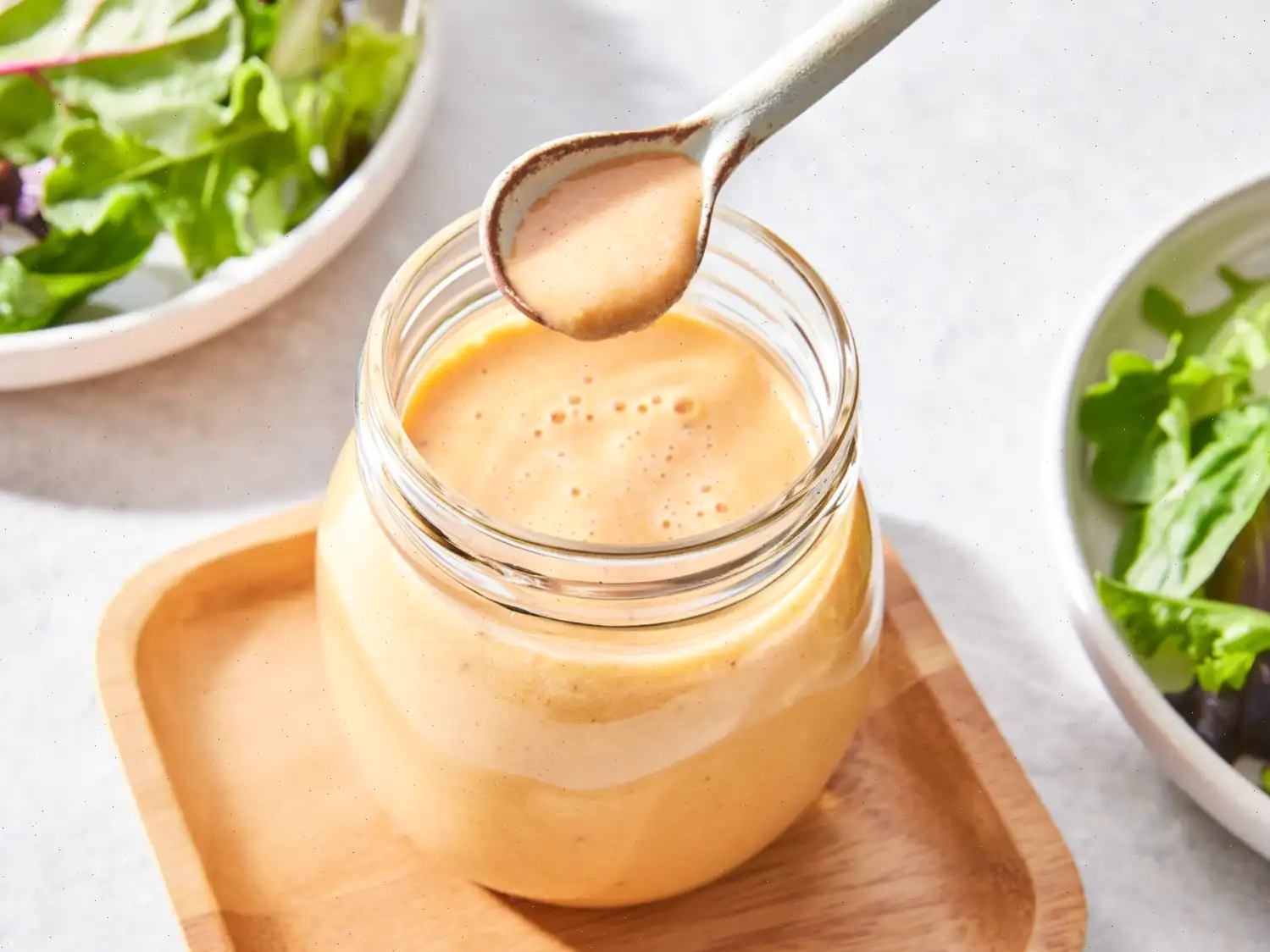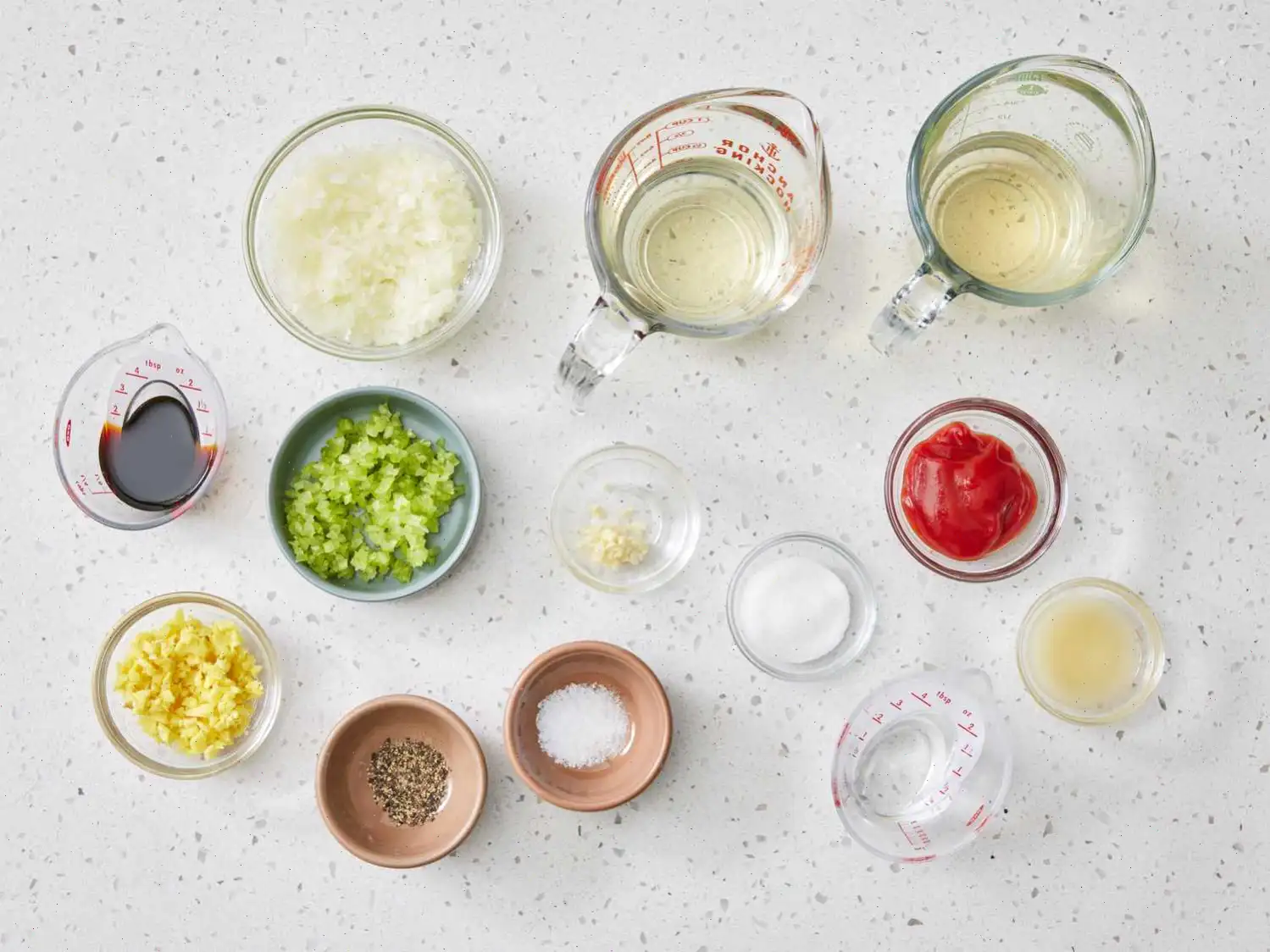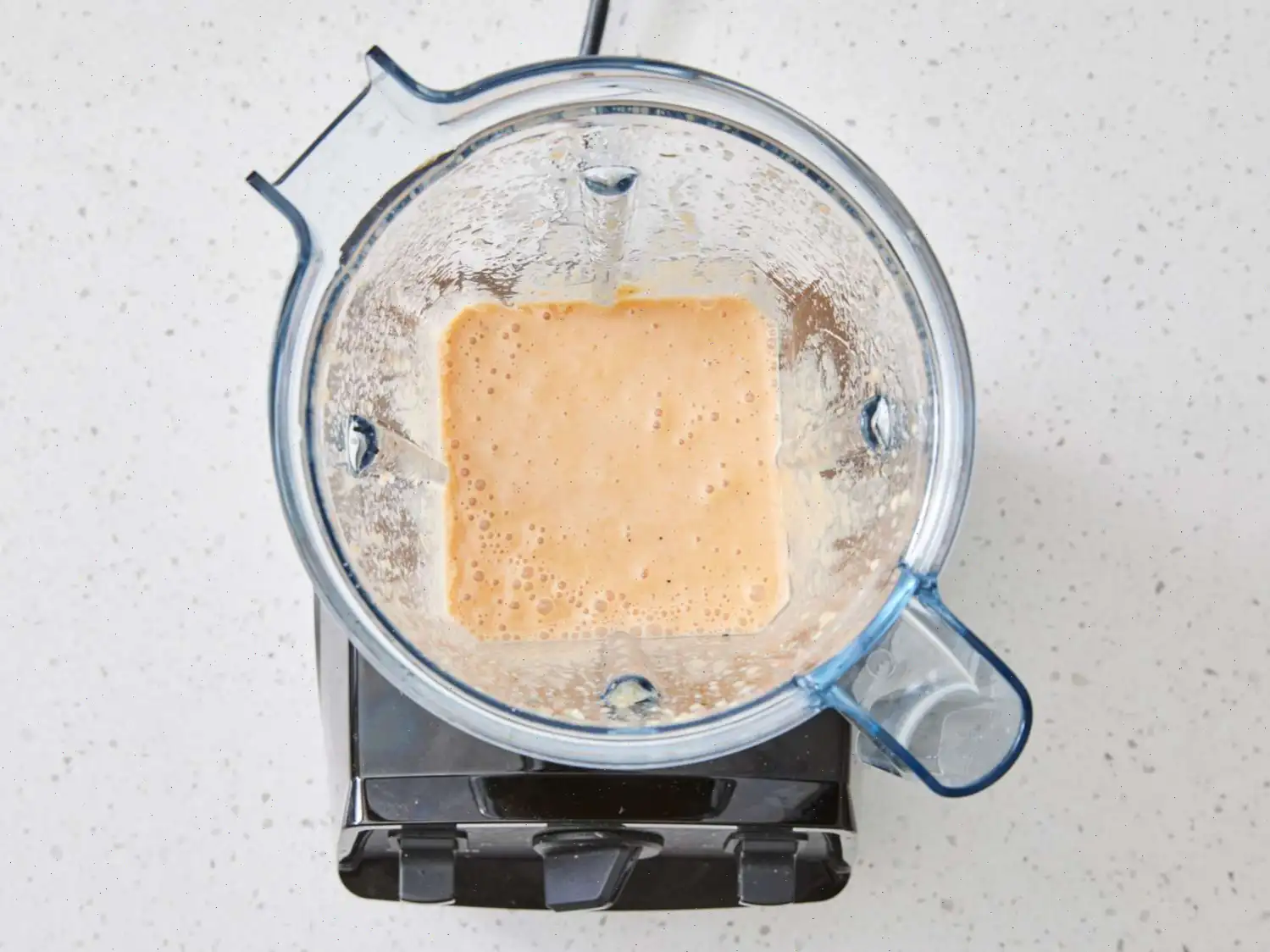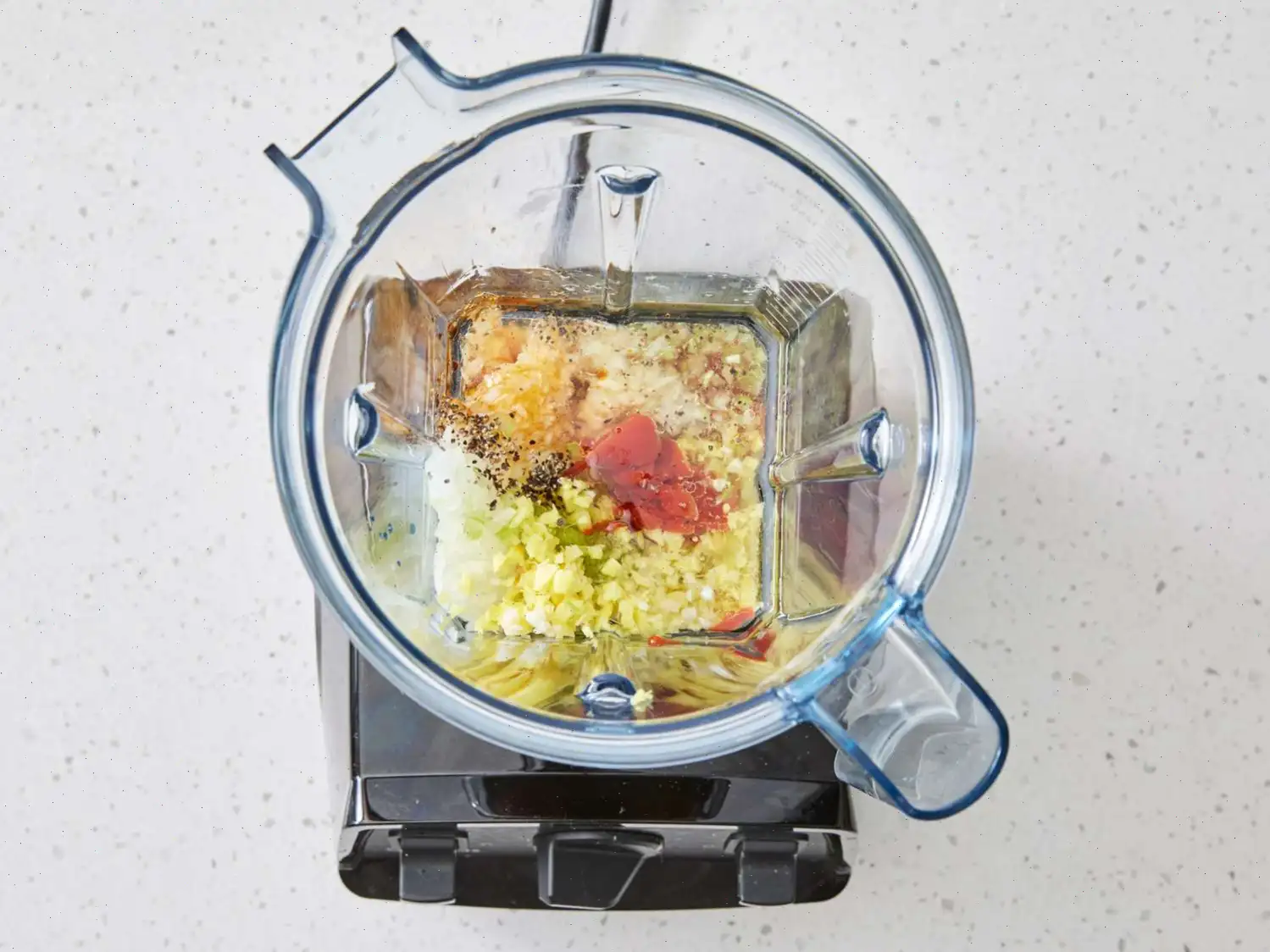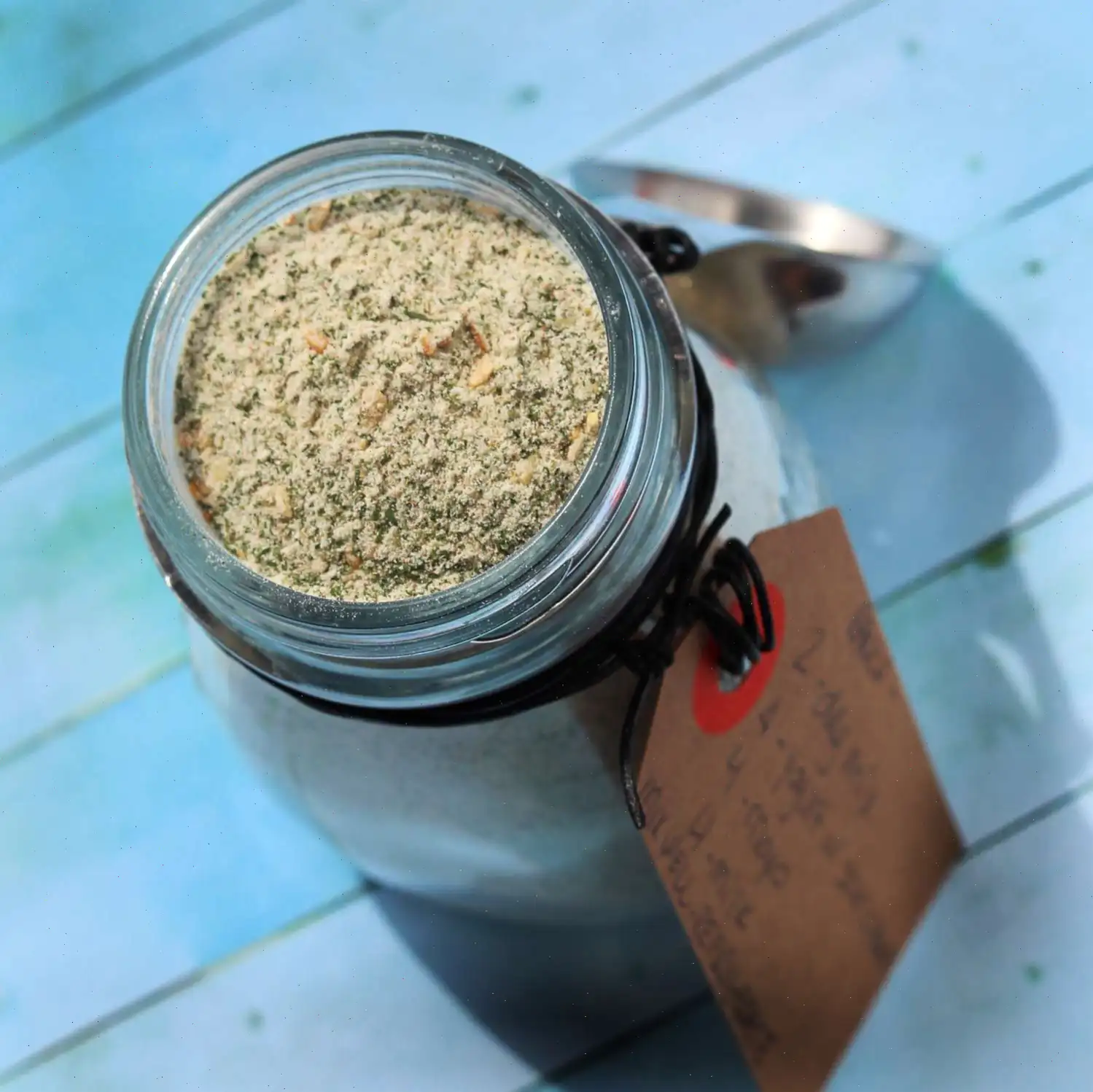
Famous Japanese Restaurant-Style Salad Dressing Recipe
Ingredients
This recipe was developed at its original yield. Ingredient amounts are automatically adjusted, but cooking times and steps remain unchanged. Note that not all recipes scale perfectly. The original recipe (1X) yields 14 servings.
- cup minced onion
- cup peanut oil
- cup rice wine vinegar
- 2 tablespoons water
- 2 tablespoons minced fresh ginger root
- 2 tablespoons minced celery
- 2 tablespoons ketchup
- 4 teaspoons soy sauce
- 2 teaspoons white sugar
- 2 teaspoons lemon juice
- teaspoon minced garlic
- teaspoon salt
- teaspoon ground black pepper
Directions
Step 1: Gather all ingredients and have them ready for blending.
Step 2: Place the minced onion, peanut oil, rice vinegar, water, ginger, celery, ketchup, soy sauce, sugar, lemon juice, garlic, salt, and pepper into a blender.
Step 3: Blend until the mixture is smooth and well-pureed, about 30 seconds.
Step 4: Once blended, the sauce is ready to serve. Enjoy!
Nutrition Facts (per serving)
Each serving contains approximately 82 calories. Below is the nutritional breakdown:
- Calories: 82
- Total Fat: 8g (10% Daily Value)
- Saturated Fat: 1g (7% Daily Value)
- Sodium: 314mg (14% Daily Value)
- Total Carbohydrate: 3g (1% Daily Value)
- Dietary Fiber: 0g (1% Daily Value)
- Total Sugars: 3g
- Protein: 0g
- Vitamin C: 1mg (1% Daily Value)
- Calcium: 3mg (0% Daily Value)
- Iron: 0mg (1% Daily Value)
- Potassium: 28mg (1% Daily Value)
* Percent Daily Values are based on a 2,000 calorie diet. Your daily values may be higher or lower depending on your calorie needs.
** Nutrient information is not available for all ingredients. Amount is based on available nutrient data.
If you are following a medically restrictive diet, please consult your doctor or registered dietitian before preparing this recipe for personal consumption.
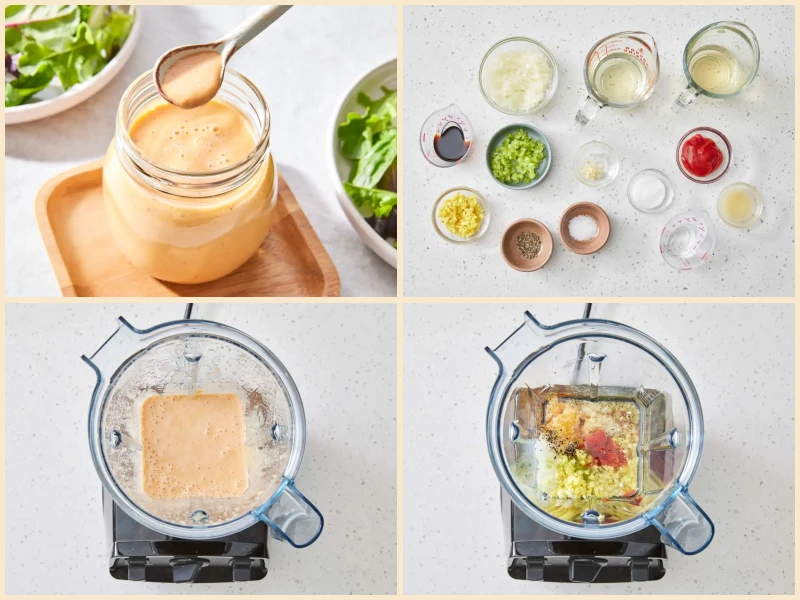
This popular Japanese restaurant-style salad dressing is a favorite for many people around the world. With its rich combination of flavors like ginger, garlic, soy sauce, and sesame, it brings a unique zest to any salad. This creamy and tangy dressing is commonly served at Japanese sushi bars and restaurants, known for its ability to enhance the flavor of fresh salads and other light dishes.
Origin of the Dish
The origin of this dressing can be traced to Japanese cuisine, although its widespread popularity outside of Japan is a more recent phenomenon. In the mid-20th century, Japanese immigrants brought their culinary traditions to the United States, and the dressing soon became a staple in many sushi restaurants. Its distinctive flavor profilecombining savory, sweet, and tangy notesquickly won over international palates, and it remains a beloved condiment in many parts of the world today.
Regional Variations
While the base ingredients of this dressing remain fairly consistent across different recipes, regional variations do exist. In Japan, the dressing might be slightly lighter, with a focus on fresh, delicate flavors. In the U.S., however, the dressing has been adapted to suit local tastes, with ingredients such as sesame oil or peanut butter sometimes being added for a richer flavor. Additionally, some variations may include mayonnaise or miso to give the dressing a thicker, creamier texture.
How it Differs from Similar Dishes
Unlike other Asian salad dressings such as the Thai peanut dressing or Chinese-style hoisin-based dressings, this Japanese salad dressing has a more delicate balance of sweet and savory flavors. The use of rice vinegar, ginger, and a touch of ketchup gives it a unique taste that sets it apart. Other dressings, such as ranch or vinaigrette, often rely on herbs and dairy products, whereas this Japanese dressing is more about umami and balance from soy sauce and ginger.
Where It's Typically Served
This dressing is most commonly served in Japanese restaurants, particularly alongside salads served with sushi or tempura. It can also be used as a dip for vegetables or as a topping for grilled fish. The creamy texture and refreshing flavors make it the perfect accompaniment to light, fresh dishes. In many sushi restaurants in the United States, this dressing is synonymous with the "house salad" served at the start of a meal, offering diners a flavorful introduction to their meal.
Interesting Facts
- Despite being a favorite in Japanese restaurants worldwide, this dressing is not traditionally found in Japan. It is more of an American invention, specifically created to appeal to Western tastes.
- The creamy texture of the dressing is largely thanks to the combination of peanut oil and sesame oil, which contribute both richness and a nutty flavor.
- The dressing is often made in large batches and can be stored in the fridge for up to a week, making it a convenient option for meal prep.
- In some variations of the recipe, additional ingredients like carrots or celery are added to give the dressing a fresher, crunchier texture.
Whether you enjoy it as a salad dressing, a dip, or even as a topping for grilled vegetables, this Japanese restaurant-style dressing brings a unique burst of flavor that pairs wonderfully with a wide variety of dishes.
FAQ about Famous Japanese Restaurant-Style Salad Dressing Recipe
Comments
Allrecipes Member
10/06/2025 01:52:54 PM
This salad dressing is THE BOMB! We love it and my guests love it too! I have to give out the recipe. I substitute 1/4 C. of chicken broth for half the oil and replace half of the oil with sesame oil. It's awesome!
Anatani0ne
03/02/2008 10:28:10 AM
This recipe gets four stars only because it does seem to call for quite a bit of personal tweaking based on individual taste. However, the ingredients are just what you need to achieve that special Ginger dressing found in most sushi restaurants. So, instead of tweaking batch after batch to reach your intended flavor, just keep close and coarsley chop each of the ingredients so they're readily available to toss into your blender as needed. And besides, I'm sure many of you true asian cuisine cooks know how little we ever measure ingredients!! To further explain: Ginger-(Best fresh from root or even the pickled kind--NOT powdered, it can add a bitter taste and ruin that light salmon color) Peanut Oil-(NOT olive oil NOR sesame oil. Tried both to frightening results. The peanut oil is key! It's what makes the creamy taste and texture) Celery-(only fresh, and don't be afraid of adding more--it gives the dressing that fresh, crisp taste) Onion and Garlic-(NO powdered stuff either, this is where you can add a little bit at a time to your blender it can indeed over power your dressing) Salt/Soy sauce-Use either, but I prefer Fish sauce as it doesn't ruin the color and since it's saltier it only requires a small amount) The Ketchup-(I just recommend a bit of fresh tomato--using ketchup can also add a funnyl, stale taste) The lemon juice & rice wine vinegar-(use the real stuff--it's not that expensive and both are versatile in lots of dishes) The Pepper & Sugar-(Didn't feel the nee
Steff
10/02/2016 05:10:01 PM
I thought this was better than my sushi restaurant serves; so fresh tasting. I made a few changes based on other reviews. I used only 1/4 C. oil, used olive because I didn't have peanut oil. Used only 2 Tbs. onion. Added a pinch of ground celery seed and added 1/4 tsp. sesame oil. I mixed it with my immersion blender. I also used low sodium soy and did not add any additional salt. I'm sure I will make this frequently!
Charline Mainprize
04/27/2019 11:01:29 PM
Verry good. Try straining half of the mixture after blending and add half the onions. I like it to sit in the fridge with shredded carrots before using( 1 hour )
Leigh Segel
08/23/2013 05:16:05 PM
This recipe does need some tweaking, but it really is a winner! I have omitted salt, ketchup, honey, celery and water altogether because they are unnecessary. I used the white part of the green onion because it is milder than regular onion. Go easy on the ginger, a little goes a long way! Do not add salt! You will get plenty of salt content from the miso and sauces. The sweetness will come from the carrot and ginger. Mine came out a nice golden yellow color. Here is my version if you want to give it a try. Just combine all the following ingredients to your food processor until well blended and then refrigerate overnight: 1/2 c. green onion (white part only) - 1 bunch yields appx. 1/4 c. 2 cloves garlic 2 carrots Juice of one lemon 1 T. Gari - Japanese pickled ginger 1. T. Tahini - Ground sesame seed paste 2 T. miso soybean paste 2 t. fish sauce 2 t. Ponzu soy sauce - Soy sauce with citrus 1/2 c. peanut oil 1/3 c. rice vinegar 12 turns of pepper mill
chefho
12/01/2019 04:19:18 AM
Not a well thought out recipe. There is absolutely no reason to waste your time "mincing" all your ingredients before you "puree" them in a blender. A simple chop would suffice and make this recipe far more efficient.
TJ Parthun
02/09/2019 10:03:13 PM
My wife and I love this kind of dressing on our salads whenever we go to Thai or Japanese restaurants, which is why we were excited to try this recipe out. I made a few modifications because we prefer the nuttier version of this dressing that we’ve had at restaurants by us. -Cut the vinegar back to 1/4 cup instead of 1/3 -Completely cut out the ketchup -Added 1/2 cup of creamy peanut butter -Added one extra teaspoon of white sugar -Added one more tablespoon of ginger paste I didn’t use fresh ginger root, but the ginger paste you can buy in the cold case of the grocery section.
OddChai9073
05/31/2024 04:10:33 PM
I halved the amount of minced garlic and found that the taste of the dressing was even better!
VioletPho3439
09/09/2023 09:44:11 PM
Trick is to add a 2nd spoon of mayonnaise leave the lemon juice out and a extra spoon of water I didn’t use garlic at all and no celery either and add the ginger bit by bit and tasting it till is on your personal taste. Mine was very light on pink color not creamy either watery just perfect to my taste.
Suzy
08/31/2016 06:22:41 PM
I loved this dressing as is but with the following changes it became a 5 star recipe: I added 1 TBS sesame oil; used low sodium Tamari in place of the soy sauce and did not add any salt; added 1/4 cup shredded carrot; used 1 small tomato and 1/4 tsp tomato paste in place of ketchup. I did not add any water as the dressing was quite fluid - it did not need water. Next time I think I will reduce the white onion and add some green onion.
Joseph Rauh
09/16/2020 02:13:20 AM
Measurements were perfect only I made some substitutions and everybody just loved it. I used avocado oil, regular white vinegar, braggs amino acids instead of soy, monk sugar adding an extra quarter teaspoon, organic ketchup and no salt
Dallas mosque48
04/26/2025 10:56:04 AM
I also used MCT (C-8) oil instead of peanut oil.
Maria Parker
02/02/2025 12:15:02 AM
I’ll be sharing this with everyone I know.
James Denn
06/23/2024 06:51:57 PM
I have made this dressing twice now; the first time was 100% as written and it was great! The second time had 1 small change; instead of using the peanut oil, I used MCT oil (C-8) and there was hardly any change in taste but much better if you’re trying to get rid of a little weight. My new “go for” salad dressing!
Taffy2020
06/09/2024 12:30:41 PM
We loved it! Only change was to use canola oil instead of peanut oil.
Donna Sammond
01/25/2024 12:30:26 AM
Not great to me. I can’t seem to find the recipe I used before, but it was delicious.
EriNnRuss
10/24/2023 01:51:40 AM
This is an excellent salad dressing. I gave it 4 stars since it didn't taste like the Japanese salad dressings I've had at restaurants.
Michael Mochizuki
12/02/2022 06:01:30 PM
Great recipe, just like in the restaurants. Not sure why others are saying not to use peanut oil, it is a key ingredient that keeps it to style with the original. I'm a big believer on adjusting ingredients based on your preferences. Me, I like to add more celery, it just freshens it up. Thanks for sharing
BlueSalad4888
08/28/2022 08:07:46 PM
I also used garlic powder onion powder & ground ginger & it was still good...way darker than I thought it would be & was wanting more of the light orange (yum yum sauce) color !
lilashaw2
08/07/2022 02:39:38 PM
Loved it. Didn't have celery but still tasted great!


